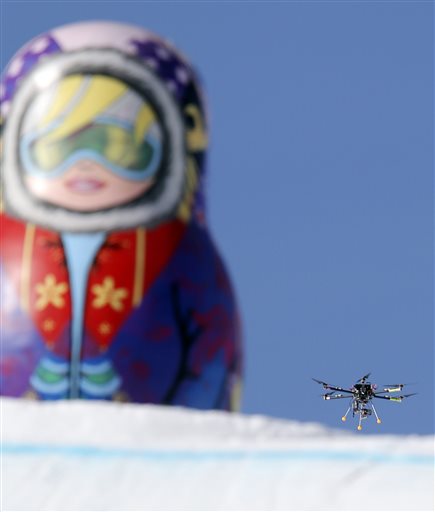SOCHI, Russia (AP) — That drone you might have spotted hovering and zipping around the Sochi Olympic slopes isn’t searching for terrorists or protesters hiding behind the fir trees.
It’s being used to transmit live video of snowboard and ski jump competitions to a screen near you.
Unlike military drones, which often look like a remote-controlled airplane, the creature floating around Sochi resembles a huge flying spider. Drones are increasingly common at sporting events, and these Olympics is the highest-profile showcase yet for their use in broadcasting.
Here’s a few questions and some answers about the drone and its place at the Sochi Games.
___
Q: Why use a drone to film Olympic events?
A: “We can go really, really close. And we are really quiet, so nobody is distracted,” said pilot and cameraman Remo Masina, who has used drones to film skiers in Switzerland for commercials.
And it’s cheaper than a camera crew on a helicopter.
A drone with mounted camera can cost anywhere from a few thousand dollars to $37,000 for a top-of-the-line Ikarus from Britain’s Heliguy, which is advising broadcast clients in Sochi on using drones, said Heliguy’s Justin Pringle.
That compares with the cost of a few thousand dollars an hour to rent a helicopter with pilot, not including the camera crew and equipment.
Flexibility is key. Drones allow unique angles and “allow more height than a crane, but are able to get lower than a helicopter,” said a statement from Olympic Broadcasting Services, which provides the official world feed of all the events at the games and is using one drone in Sochi.
Broadcasting live from a remote-controlled device is more complicated than recording, but not hugely so. It requires an extra transmitter to send back live video, which adds weight and limits how fast the drones can fly. But Masina, who is not involved in the Olympic footage, said he can still fly a drone at up to 40 mph while transmitting a high-definition, live image.
___
Q: How does the drones work?
A: The legs of this flying spider hold the rotors that spin around to keep it airborne. The drone then has a flight deck that holds the flight control system with GPS for navigation, sensors and receivers. Then there’s the camera, which can be mounted in the middle or suspended below the flight deck.
Drones are being used to film major movies and television shows — Heliguy has provided drones for filming of the HBO series “Game of Thrones.” As demand grows, cameras are being designed with drones in mind.
Back on the ground, the pilot has a control deck, with monitors that show a real-time view of what the camera is capturing, as well as flight details including altitude, speed, rate of descent and ascent, and how much power is left in the battery.
Battery capacity is a limitation. Most drones can only run 40 minutes before they need to be recharged. But recharging video drones is still quicker and cheaper than refueling a helicopter.
Also appearing in Sochi are cameras running on cables. They’re also above the action, but have a more limited ability to move around a venue than does a free-flying drone.
___
Q: Couldn’t a drone crash onto the crowd?
A: It could, but so could a much heavier helicopter.
Masina said chances of drone crashes are close to zero when a drone is handled by an experienced pilot, because the drones are programmed to return to base at the slightest problem — such as a low battery, rough winds or a malfunction.
There have been mishaps, however. In one case last year, a drone filming an imitation version of Spain’s running of the bulls in Virginia crashed and injured a few spectators.
___
Q: Could hackers divert a drone?
A: It’s possible. While military drones use encrypted GPS signals for navigation, the GPS signals used by civilian drones don’t have that protection.
A team at the University of Texas successfully hacked a drone in an experiment in 2012 through something called “spoofing,” or sending the drone incorrect information about its location. Todd Humphreys, head of the school’s Radionavigation Lab, told a Congressional hearing it would be very difficult for an ordinary person to spoof a drone, although it might be within the capability of a terrorist or criminal network.
Cybersecurity has been a fear in Sochi, given the huge numbers of people in a relatively compact space and the sharp reputation of Russian hackers.
But since the video drones are not armed, there’s a limit to the damage a hacker could do with them.
___
Q: Are drones legal to fly?
A: Local laws vary widely in terms of who can fly drones, where and for what purpose. Many countries impose restrictions for reasons of security and privacy, and so they won’t interfere with airplanes.
For the Sochi Games, Olympic Broadcasting Services said a flight plan must be filed with the Russian civil aviation authority and permission obtained from local Russian police and the FSB, the successor to the KGB.
The Russian government also bought a fleet of drones to help spot terrorists or troublemakers in the Sochi area, operated by its security services.
In some countries, it’s illegal to fly over crowds. Some countries require civilian users to keep the drone within sight of the pilot. Others have altitude restrictions. In the U.S., the Federal Aviation Administration has been working for more than four years on regulations for the commercial use of small drones.
___
Q: So, is this the future of sports video?
A: Masina doesn’t hesitate. “For sure.”
___
Follow Angela Charlton on Twitter at http://twitter.com/acharlton

COMMENTS
Please let us know if you're having issues with commenting.